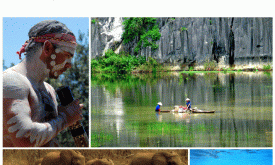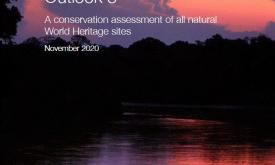PAME Assessment Tools

IUCN Green List of Protected and Conserved Areas
The IUCN Green List of Protected and Conserved Areas is the first global standard of best practice for area-based conservation. It is a programme…
The IUCN Green List of Protected and Conserved Areas is the first global standard of best practice for area-based conservation. It is a programme of certification for protected and conserved areas – national parks, natural World Heritage sites, community conserved areas, nature reserves and so on – that are effectively managed and fairly governed. By giving recognition to well-managed and well-governed protected and conserved areas, the IUCN Green List aims to increase the number of natural areas delivering long-lasting conservation results for people and nature.
How it works
Sites join the IUCN Green List by committing to achieving its standard. They become certified once they demonstrate a high bar of environmental and social performance. The IUCN Green List Standard addresses four themes: good governance, sound design and planning, effective management, and positive conservation outcomes. The time from application to certification depends on the management quality of the site at the time of application. Sites choose when they are ready for evaluation, and have up to a maximum of five years to achieve certification, which is valid for a five year period. During that time, sites are regularly evaluated and reviewed against a set of demanding criteria. Enrolled sites therefore benefit from expert guidance on how to improve their performance and impacts. They also become part of a network, fostering exchange and learning among conservation practitioners.
The IUCN Green List Standard provides a global framework for assessing, improving and recognizing the performance of protected and conserved areas; however, as such it is not one of the common methodologies to evaluate the management effectiveness of protected and conserved areas. Other assessment tools introduced in this PAME Dashboard, such as IMET and METT, have been developed for that purpose and can also support protected and conserved areas in the Green Listing process.
For further information on IUCN Green List of Protected and Conserved Areas please refer to:
IUCN Green List of Protected and Conserved Areas: Standard, Version 1.1
IUCN Green List of Protected and Conserved Areas: User Manual, Version 1.2
Please check the IUCN Green List website to make sure you use the latest Standard and User Manual: https://iucngreenlist.org/
Monitoring Important Bird and Biodiversity Areas (IBAs)
BirdLife International has developed this global framework for monitoring the conservation status of, threats to, and conservation actions at IBAs…
BirdLife International has developed this global framework for monitoring the conservation status of, threats to, and conservation actions at IBAs.
IBAs are internationally important places for birds, and therefore, biodiversity conservation. We need to understand what is happening to them in order to adapt our interventions accordingly. Monitoring is needed both to assess the effectiveness of conservation measures and to provide an early warning of problems. BirdLife has a standard ‘Pressure - State - Response’ framework that is simple, flexible and practical enough to be implemented effectively across an enormous range of sites. The framework allows national data to be compiled at the sub-regional, regional and global levels in order to fulfil the wider aims of the BirdLife Partnership.
Citation: BirdLife International (2006). Monitoring Important Bird Areas: a global framework. Version 1.2. BirdLife International, Cambridge, UK.

World Heritage Outlook Assessments
IUCN has developed this standardized methodology for Conservation Outlook Assessments of natural World Heritage sites.
The IUCN World…
IUCN has developed this standardized methodology for Conservation Outlook Assessments of natural World Heritage sites.
The IUCN World Heritage Outlook is the first global assessment process for all natural and mixed World Heritage sites, and composed of a interactive website and a three-yearly global report. The IUCN World Heritage Outlook provides Conservation Outlook Assessments for all natural World Heritage sites. These assessments indicate whether a natural World Heritage site is likely to conserve its values over time, based on a desk-based assessment of 1) the current state and trend of values, 2) the threats affecting those values, and 3) the effectiveness of protection and management. Conservation Outlook Assessments also compile additional information on benefits and possible projects related to a site. For further information on IUCN's World Heritage Outlook Assessments please refer to:
IUCN (2012). IUCN Conservation Outlook Assessments – Guidelines for their application to natural World Heritage sites. Version 1.3. IUCN, Gland, Switzerland.
Osipova, E. et al. (2014). IUCN World Heritage Outlook 2014: A conservation assessment of all natural World Heritage sites. IUCN, Gland, Switzerland.
Osipova, E. et al. (2017). IUCN World Heritage Outlook 2: A conservation assessment of all natural World Heritage sites. IUCN, Gland, Switzerland.
Osipova, E. et al. (2020). IUCN World Heritage Outlook 3: A conservation assessment of all natural World Heritage sites. IUCN, Gland, Switzerland.
How is your MPA doing?
A guidebook of natural and social indicators for evaluating marine protected areas (MPAs) management effectiveness.
IUCN, WWF and the US…
A guidebook of natural and social indicators for evaluating marine protected areas (MPAs) management effectiveness.
IUCN, WWF and the US National Oceanic and Atmospheric Administration (NOAA) have developed this guidebook to assist marine protected area (MPA) managers in assessing the performance of their MPA. Based on this assessment, it shows how necessary changes can be made to improve management measures. It presents a flexible approach that can be used in many types of MPA and offers a variety of specific biological, socio-economic and governance indicators to measure the effectiveness of management actions in achieving MPA goals and objectives.
Citation: Pomeroy, R.S., Parks, J.E. and Watson, L.M. (2004). How is your MPA doing? A Guidebook of Natural and Social Indicators for Evaluating Marine Protected Area Management Effectiveness. IUCN, Gland, Switzerland and Cambridge, UK.
Integrated Management Effectiveness Tool (IMET)
IMET is a Protected Area Management Effectiveness …
IMET is a Protected Area Management Effectiveness (PAME) tool that allows an in-depth assessment of marine and terrestrial protected areas, regardless of their management categories and governance type. It is also a decision support tool that helps protected area managers take analysis-based management decisions for improved conservation outcomes.

Release of IMET 2.2 on June 25th, 2021:
Poster in English and in French
Download here IMET 2.2
IMET is a PAME tool – but also much more:
-
As a PAME tool, IMET identifies management strengths, constraints, and weaknesses of a protected area management.
-
IMET considers the key values of the protected area throughout the assessment to ensure that the overall scope of management is results-oriented. In this way, it supports the identification of the urgency and conservation priorities.
-
IMET embeds an inherent dimension of capacity building on protected area planning, monitoring, and evaluation to serve outcome-oriented management.
-
IMET exercise also supports the application of the protected area to the Green List.
IMET unique characteristics
-
IMET is a software that can be downloaded free of charge on a PC, that does not require an internet connection.
-
IMET combines the analysis of the protected area surrounding environment with the internal management assessment to obtain a clearer understanding of the management context and challenges.
-
IMET encourages participatory assessment and decision-making process, building a collective understanding of how the management functions. It is helpful to develop or renew a work plan or a management plan.
-
IMET includes data visualization that facilitates the analysis and presentation of results at soon as the assessment is completed.
-
IMET provides an automatic management analysis report that can be easily shared to protected area authorities and partners, the IMET (PAME) Analysis Report.
-
IMET stores the information in a database allowing processing and visualisation for more detailed analysis at site or system level.
-
IMET specialists (coaches) are available to support the IMET assessment, and result analysis. They form a supportive community to leverage capacity for planning, management, and even policy-making.
Key features of the IMET2.2 version
This new IMET version (IMET2.2, June 2021) includes several new features. The main ones are:
-
Two additional languages: Spanish, and Portuguese, in addition to English and French.
-
A third module, the IMET Analysis Report, which is automatically generated, editable, and printable for PAME reporting.
-
Possibility to work on any protected area, including those not featured in the WDPA.
-
Self-updating: no need to download any future version anymore!
-
Export/import functionality which allows sharing assessments in JSON format.
-
Possibility to generate a new IMET pre-filled with data from previous ones.
-
Merge conflicting or duplicates assessments (same PA and same year).
-
More user-friendly and ergonomic: visually attractive, a printing function, automatic information transfer, and more straightforward navigation between modules.
-
Increased software quality: self-updating, maintainability, stability.
The IMET 2.2 Technical Note provides the detailed list of all the additional functions with regards to the previous versions.
How to install it
Please, carefully refer to the following IMET installation note
If needed, IT technical support can be provided by writing at the following email address: JRC-IMET-TECHNICAL-SUPPORT@ec.europa.eu
How to use IMET
Typically, the first IMET assessment consists of a 3-4 day workshop with the protected area team and key stakeholders facilitated by one or two IMET coaches. The IMET Handbooks, the COMIT (2016) and the COMIT 2 (in course of finalization and about to be published by IUCN both in French and in English), explain each assessment question and presents guidelines on assessment implementation with the coaching process. It also provides avenues for increasing capacity in protected area management and analysis.
We invite you to report your IMET assessment to the Regional Observatories of biodiversity and protected areas Caribbean; Central Africa; Eastern and Southern Africa; Pacific; West Africa and to the GD-PAME WDPA.
Resources
-
examples of IMET success stories in Burundi, Cameroon-Chad and Gabon
Management Effectiveness Tracking Tool (METT)
The Management Effectiveness Tracking Tool (METT) was designed to measure progress in management effectiveness at particular sites over time.…
The Management Effectiveness Tracking Tool (METT) was designed to measure progress in management effectiveness at particular sites over time.
First published in 2002, the METT was one of the first tools developed to reflect the IUCN WCPA framework for protected area management effectiveness, and since then it has become one of the most used PAME tools across the globe. Several versions of the METT and many adaptations have been produced, reflecting lessons learned through implementation; by 2016 the METT had been applied in 127 countries worldwide.
In 2020 a new version of the METT (the fourth version, METT-4) was developed. METT-4 draws together the lessons learned from applying the tool around the world. For the first time, METT-4 is presented as an Excel tool which aids implementation and compilation of results. The METT-4 consists of two main sections: 1) datasheets of key information on the protected area and 2) an assessment form that provides a composite measurement across 38 parameters integrating all six components of the IUCN WCPA framework. The METT Handbook published in 2016 will be updated in 2021 to reflect the revised METT-4.
The METT-4 Excel Workbook and Guidance are available here and on the Protected Planet website:
https://www.protectedplanet.net/en/thematic-areas/protected-areas-management-effectiveness-pame?tab=METT
The METT was designed primarily to track progress over time at a single site and to identify actions to address management issues; rather than to compare management between different sites. For further information on the METT please refer to:
Stolton, S., Hockings, M., Dudley, N. (2020). Management Effectiveness Tracking Tool. Reporting Progress at Protected Area Sites: Fourth Edition. Excel Workbook and Guidance.
Stolton, S. and Dudley, N. (2016). METT Handbook: A guide to using the Management Effectiveness Tracking Tool (METT). WWF-UK, Woking, UK.
Stolton S. et al. (2007). Management Effectiveness Tracking Tool (METT). Reporting Progress at Protected Area Sites: Second Edition. WWF and The World Bank.

